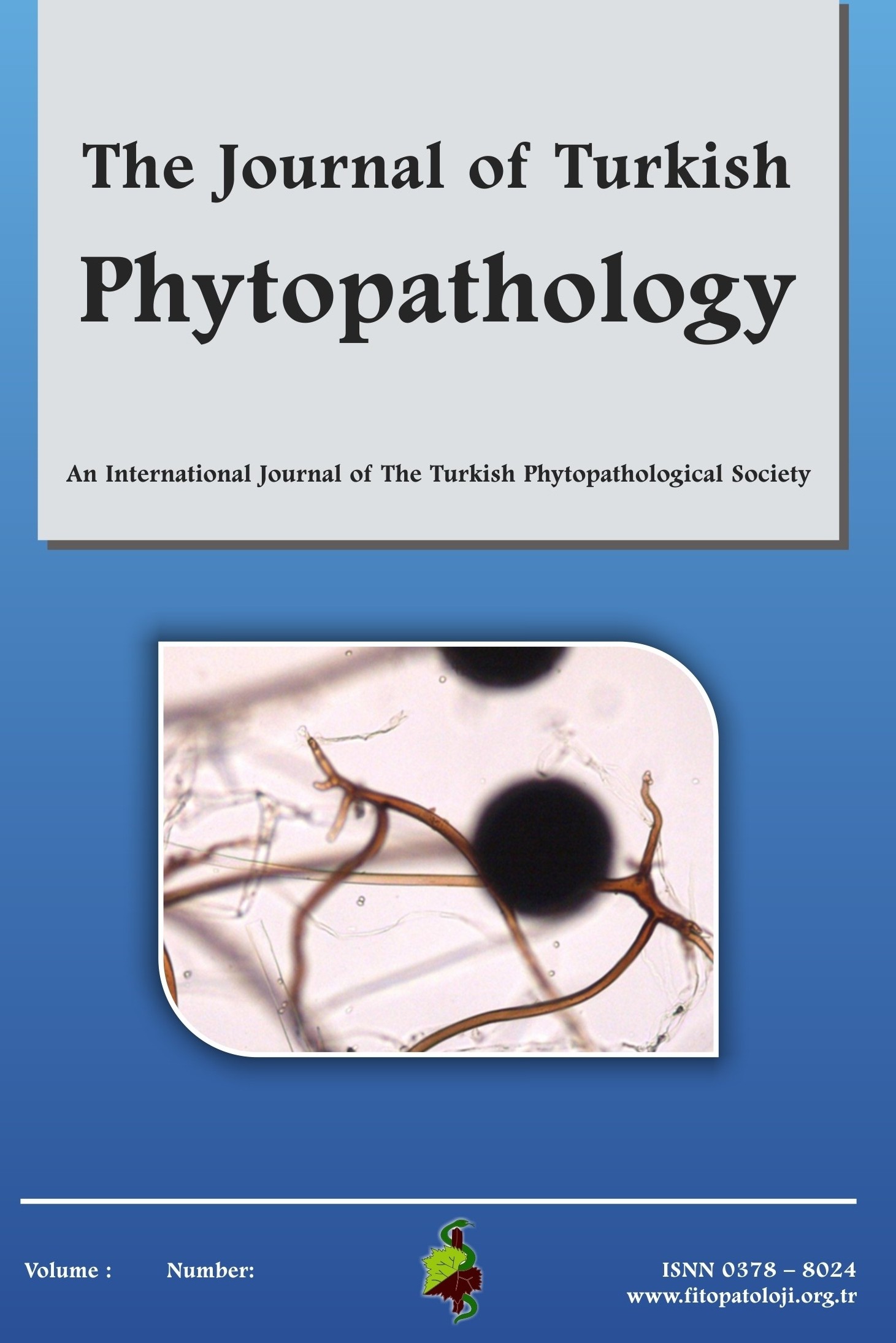Determination of the Best Forecast System for the Prediction of the Tomato Late Blight in the Field Tomato Growings of Balıkesir and Çanakkale provinces
Determination of the Best Forecast System for the Prediction of the Tomato Late Blight in the Field Tomato Growings of Balıkesir and Çanakkale provinces
A large number of late blight forecasting models
exist and are currently used in many tomato and potato production areas
throughout the World. The use of forecast systems to predict disease has the
potential of reducing fungicide applications without reducing yield. This study
carried out in the tomato growing areas of Balıkesir (Merkez, Manyas, Susurluk)
and Çanakkale (Batak ovası) provinces between the years of 2006-2010. In the
region where the automatic weather stations were located no fungicide
applications were carried out in the control tomato fields until the occurrence
of the first symptoms of the disease on the plants. Surveys were carried out
once and sometimes twice a week to
determine the occurence of the first
symptoms of the disease. Comparisons were made between the predictions of the
model and the actual date of the occurence of the blight late in the field ,with aim to verify
the suitibility of the tested model. In
study had used SMITH, Fry Phytophtora Unit, IPI, TOMCAST and Tomcast model was
used with modification as named modified
TOMCAST forecasting models which are predict infection conditions of tomato
late blight, caused by Phytophthora
infestans. These models were compared between the actual date when blight
was found in the crop and predict infection date of these models. Thus, The
most appropriate models were determined according to study
areas. After result of study, modified TOMCAST model were found to be the
suitable at Balıkesir regions. and SMITH model were found to be the suitable at
Çanakkale regions.
Keywords:
Late blight, Tomato, Forecast Models,
___
- Agrios, G., 2005 Plant Pathology. 5th ed. Academic Pres, Inc. San Diego, CA, 925 p Anonymus., 2013,www.tuik.gov.tr, 2.11.2014 Apaydın, A., O. Çakır., H. Kar., C. Özdemir., ve A.Gemici, 2000. Karadeniz Bölgesinde Domates Mildiyösünün Tahmin Uyarıya Esas Teşkil Edecek Kriterlerinin Araştırılması, Sonuç Rap., K.T.A.E.-Samsun. Baykal, N., 1995. Fitopatoloji, Uludağ Üniversitesi Basımevi, 47-49s. Bursa Bolkan, H. and W.R. Reinert.,1994. Developing and Implementing IPM Strategies to Asist Farmers: An Industry Approach. Plant Disease, 78 (6), 545-550. Bugiani, R., P. Cavanni, and I. Ponti.,1993. An advisory service for the occurrence of Phytophthora infestans on tomato in Emillia- Romagna region. Bulletin OEPP/EPPO Bulletin 23, 607-613 Forsund, E.,1983. Late bligt forecasting in Norway 1957-1980. EPPO Bull. 13 (2) 255-258 Fry, W. E., A. E. Apple, and J. A. Bruhn.,1983. Evaluation of potato late blight forecasts modified to incorporate host resistance and fungicide weathering. Phytopathology 73:1054-1059. Fry, W.E., S.B. Goodwin., 1997. Re- emergence of potato and tomato blight in the United States. Plant disease, 81: 1349-1357. Fry, W. E.,1999. http//ppathw3.cals.cornell.edu/fry Harrison, J.G. and R. Lowe.,1989. Effect of humidity and air speed on sporulation of P. infestans on potato leaves. Plant Pathology 38: 585-591. Harrison, J.G., 1992. Effects of the aerial environment on late blight of potato foliage. Plant pathology, 41:384-416. Harrison, J.G., 1995. Factors involved in the development of potato late blight diseases (phytophthora infestans) Pages 215-236 in Potato Ecolgy and Modelling of Crops Under Conditions Limiting Growth. A.J. Haverkort and D.K.L. McKerron, eds. Kluwer Acsdemic Publishers, Dordrecht, Netherlands. Hyre, R.A.,1954. Progress in forecasting late blight of potato and tomato. Plant Disease Reporter, 38: 245-253 Mcload, A., S. Denman., A. Sadie., F.D.N. Denner. 2001. Characterization of South african Isolates of phytophthora infestans. Plant dis., 85:287-291. Madden, L., S.P. Pennypacker and A. MacNab, 1978, Tom-cast, tomato disease forecaster. Phytopathology 68: 1354-1358 Onoğur, E., 1996, Bitki Fungal Hastalıkları 1., E.Ü.Zir. Fak. Ofset Basımevi, 214s. Peters, R.D., H.W. Plant., R. Hall, 1998. Characterization of changes in populations of phytophthora infestans in canada during mating types and metalaxyl sensitivity markers. Can J. Of Plant Pathology, 20: 259-273. Sato, N. 1994. Effect of sporulating temperature on the limit temperature in indirect germination of the sporangia of P. infestans. Ann. Phytopath. Soc. Japan. 60:60-65. Schepers, H.T.A.M., E. Bouma., C.B. Bus,1996. State of the art of Phytophthora infestans control in Europe Erno Bouma & Huub Schepers (eds) Proceedings of the Workshop on the European network for development of an integrated control strategy of potato late blight Lelystad, The Netherlands 30 September - 3 October Smith, L.P., 1956. Potato blight forecasting by 90 % humidity criteria. Plant Pathology 5:83-87 Steveenson, W.R., 1993. Management of Early Blight and Late Blight. In: Potato Health Management. Ed: R.C. Rowe. APS Pres, 141-147. Tosun, N., H. Turkusay., H. Saygılı., B. Tanyolaç., 2003. Sanayi domatesi yetiştiriciliğinde geç yanıklık (Phytophthora infestans (Mont.) deBary) hastalığının kontrolünde erken uyarı sisteminin kullanılması üzerinde araştırmalar. Ege Üniversitesi bilimsel araştırma proje raporu, 2000/Bil/005, İZMİR. (Yayınlanmamış Rapor) Tosun, N., A.Yıldırım., H. Turkusay., B. Tanyolaç., 2007. Genetic variation among Phytophthora infestans (Tomato Blight) izolates from western Turkey revealed by inter simple sequence repeat (ISSR) and random amplified polymorphic DNA (RAPD) markers. Pak. J. Bot., 39(3): 897-902. Trentin, G., A.B. Heldwein., L. Streck., G.F. Maass., S.Z. Radons., R. Trentin,2009. Controlling potato cv. ‘Asterix’ late blight base on forecast systems. Ciencia Rural, v.39, n.2, p.393-399. Ullrich, J. and H. Schrodter, 1966. Das problem der Vorhersage des Auftretens der Kartoffelkrutfaule (Phytophthora infestans) und die MoglichkietvseinervLosung eine Negativprognose. Nechricten Dt Pflanzenschutzdienst (Braunschweig), 18:33-40. Wallin, J.R. and P.E. Waggoner, 1951. The ınfluence of climate on the develepmont and spread of Phytophthora infestans in articially inoculated potato plots. Plant Disease Reporter Suppl. 190: 19-33.
- ISSN: 0378-8024
- Yayın Aralığı: Yılda 3 Sayı
- Başlangıç: 1971
- Yayıncı: Türkiye Fitopatoloji Derneği
